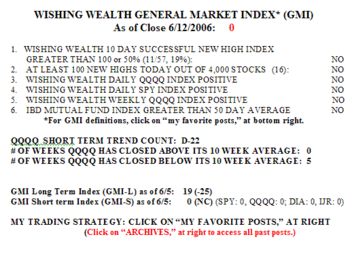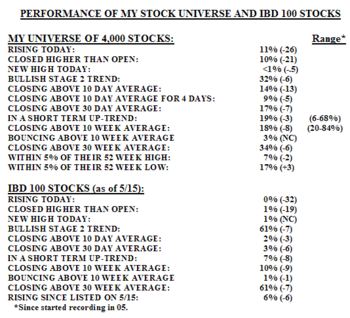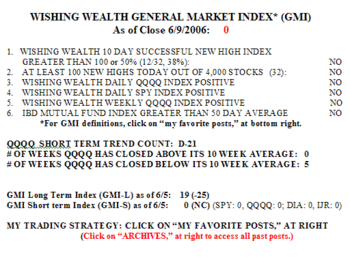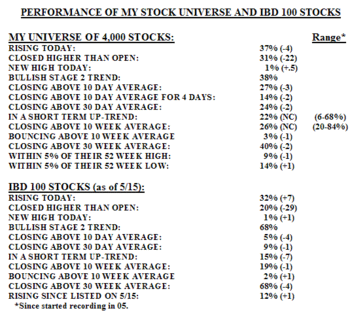Not much new on Tuesday. The GMI is at zero. More stocks advanced than on Monday; 35% of the Nasdaq 100, 22% of the S&P 500 and 23% of the Dow 30 stocks. Only 9%of the Nasdaq 100 stocks are now above their 30 day averages. 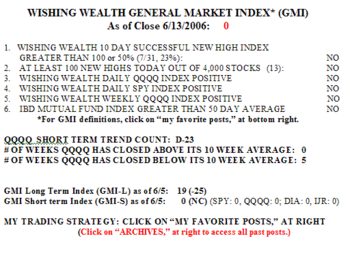 There were only 13 new highs and 292 new lows in my universe of nearly 4,000 stocks. The QQQQ is now in its 23rd day of a decline. My stats are now around the levels last seen in October, 2005, when that decline was ending. It remains to be seen whether we are near a bottom or at the beginning of a major decline.
There were only 13 new highs and 292 new lows in my universe of nearly 4,000 stocks. The QQQQ is now in its 23rd day of a decline. My stats are now around the levels last seen in October, 2005, when that decline was ending. It remains to be seen whether we are near a bottom or at the beginning of a major decline.
The IBD 100 stocks again fared worse than my universe of stocks. 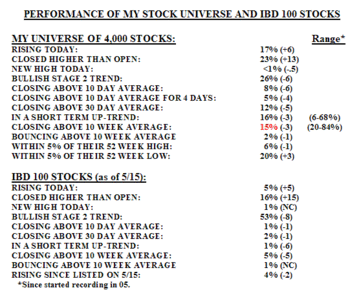 5% of the IBD 100 stock posted on 5/15 rose on Tuesday, compared with 17% of my stock universe. However, one bright spot was that 16% of the IBD 100 stocks and 23% of my universe of stocks closed higher than they opened the day. There were almost no new highs in both groups of stocks. Three times as many stocks in my universe are within 5% of a new low than a new high (20% vs. 6%). Only 15% of the stocks in my universe closed above their 10 week averages, a new low since I began recording this statistic in 2005. Almost all of the IBD 100 stocks closed below their 10 day, 30 day and 10 week averages. Still, twice as many IBD 100 stocks remain in a bullish stage 2 up-trend (53% vs 26%).
5% of the IBD 100 stock posted on 5/15 rose on Tuesday, compared with 17% of my stock universe. However, one bright spot was that 16% of the IBD 100 stocks and 23% of my universe of stocks closed higher than they opened the day. There were almost no new highs in both groups of stocks. Three times as many stocks in my universe are within 5% of a new low than a new high (20% vs. 6%). Only 15% of the stocks in my universe closed above their 10 week averages, a new low since I began recording this statistic in 2005. Almost all of the IBD 100 stocks closed below their 10 day, 30 day and 10 week averages. Still, twice as many IBD 100 stocks remain in a bullish stage 2 up-trend (53% vs 26%).
I remain in cash and/or holding puts on some weak stocks. The Dow could rally some 240 points before I would consider that a new up-trend had begin. The markets remain in a confirmed down-trend. By now, everyone should see through the widely proclaimed conventional nonsense that stocks have intrinsic value. Stocks are only worth what someone else will pay for them. And each person’s assessment is driven more by mob psychology and greed and fear, than by rational logic. How else can you explain why a stock like GS can release great earnings and be punished like it was on Tuesday. In a down-trend, all events are seen through a dark glass that is perceived to be half empty. Everyone sells quickly because they think that the next guy will sell. As William O’Neil says, all stocks are bad unless they are going up. But I say that "bad" stocks can make a trader a lot of money if s/he shorts them correctly. (My TC2005 scan of the market found 232 Submarines and only 2 Rocket stocks on Tuesday evening.)
Please send your comments to: silentknight@wishingwealthblog.com.
